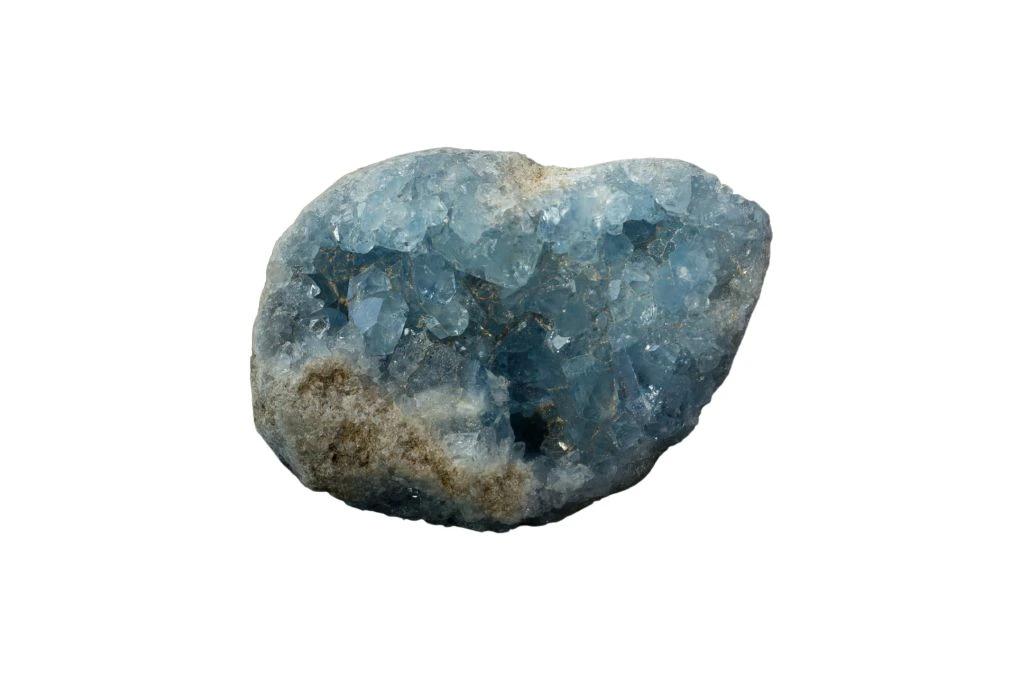Color and Appearance of Celestite
Celestite, also known as celestine, is renowned for its ethereal beauty and delicate appearance. This striking mineral typically displays a pale blue to sky-blue coloration, although it can also occur in white, colorless, pale yellow, and light red hues. The blue variety is the most sought-after and recognizable form of celestite, often resembling a piece of the sky captured in crystalline form.
Crystal Structure and Formation
Celestite forms in the orthorhombic crystal system, often creating prismatic or tabular crystals. These crystals frequently grow in clusters or geodes, with individual specimens ranging from small, needle-like formations to large, well-developed crystals that can reach several inches in length. The mineral’s structure allows for excellent cleavage, resulting in smooth, reflective surfaces that contribute to its lustrous appearance.
Notable Physical Characteristics
One of the most distinctive features of celestite is its vitreous to pearly luster, which gives the crystal a captivating shine and sparkle. The transparency of celestite varies from transparent to translucent, with some specimens exhibiting a subtle opalescence. Additionally, celestite has a relatively low hardness on the Mohs scale, ranging from 3 to 3.5, making it a delicate mineral that requires careful handling.
Unique Aspects and Features
What truly sets celestite apart is its ability to form large, breathtaking geodes. These hollow rock formations lined with celestite crystals can reach impressive sizes, sometimes large enough for a person to stand inside. The contrast between the rough exterior of the geode and the gleaming, crystal-studded interior creates a mesmerizing spectacle. Furthermore, celestite’s association with celestial themes, due to its name and sky-blue color, has made it a favorite among crystal enthusiasts and collectors, often prized for its perceived metaphysical properties and aesthetic appeal.
Historical and Cultural Significance of Celestite
Celestite, also known as celestine, has been revered for centuries across various cultures. Ancient civilizations, particularly in Egypt and Greece, prized this mineral for its ethereal blue color, associating it with the heavens and divine realms. In medieval Europe, celestite was often incorporated into religious artifacts and was believed to facilitate communication with angelic beings.
Metaphysical Associations
In the realm of crystal healing and metaphysics, celestite is strongly linked to spiritual growth and higher consciousness. It is thought to promote mental clarity, inner peace, and enhanced intuition. Many practitioners believe that celestite can help open and activate the third eye and crown chakras, facilitating access to higher realms of consciousness and spiritual wisdom.
Common Uses and Applications
Today, celestite finds applications in both practical and spiritual contexts. Industrially, it serves as a source of strontium for fireworks and other pyrotechnics. In alternative healing practices, celestite is commonly used in meditation, placed on altars, or worn as jewelry. Many people keep celestite in their bedrooms to promote restful sleep and encourage vivid dreams.
Believed Benefits
Proponents of crystal healing attribute numerous benefits to celestite. It is said to reduce stress and anxiety, promote emotional balance, and enhance creative expression. Some believe it can aid in treating eye and ear disorders, while others use it to support treatments for cellular disorders and detoxification. In spiritual practices, celestite is thought to facilitate astral travel, enhance psychic abilities, and foster a deeper connection with one’s guardian angels or spirit guides.

